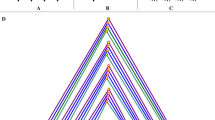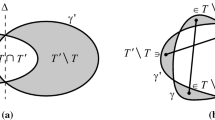Abstract
We consider the problem of separating a collection of isothetic polygons in the plane by translating one polygon at a time to infinity. The directions of translation are the four isothetic (parallel to the axes) directions, but a particular polygon can be translated only in one of these four directions. Our algorithm detects whether a set is separable in this sense and computes a translational ordering of the polygons. The time and space complexities of our algorithm is Θ(n log n) and Θ(n) respectively, where n is the total number of edges of the polygons in the set. The best previous algorithm in the plane for this problem had complexities of O(n log2 n) time and O(n log n) space.
Preview
Unable to display preview. Download preview PDF.
Similar content being viewed by others
References
P. K. Agarwal, M. de Berg, D. Halperin and M. Sharir. ”Efficient generation of k-directional assembly sequences”, Proc. 7th ACM-SIAM Symp. Discrete Algorithms, (1996), pp. 122–131.
M. de Berg, H. Everett and H. Wagener. ”Translation queries for sets of polygons”, Internat. J. Comput. Geom. Appl., Vol. 5, (1995), pp. 221–242.
B. Chazelle, Th. Ottmann, E. Soisalon-Soininen and D. Wood. ”The complexity and decidability of SEPARATION TM”, Proc. International Colloquium on Automata, Languages and Programming, (1984), LNCS 172, pp. 119–127.
F. Dehne and J.-R. Sack. ”Translation separability of sets of polygons”, The Visual Computer, 3, (1987), pp. 227–235.
M. Devine and D. Wood. ”SEPARATIONTM in d dimensions or strip mining in asteroid fields”, Comput. and Graphics, Vol. 13, No. 3, (1989), pp. 329–336.
L. J. Guibas and F. F. Yao. ”On translating a set of rectangles”, in Advances in Computing Research, Volume I: Computational Geometry, Ed. F. P. Preparata, JAI Press Inc., (1983), pp. 61–77.
D. Nussbaum and J.-R. Sack. ”Disassembling two-dimensional composite parts via translation”, International Journal of Computational Geometry & Applications, Vol. 3, No. 1, (1993), pp. 71–84.
Th. Ottmann and P. Widmayer, ”On translating a set of line segments”, Computer Vision, Graphics and Image Processing, Vol. 24, (1983), pp. 382–389.
F. P. Preparata and M. I. Shamos. Computational Geometry: an Introduction, Springer-Verlag, 1985.
J. Reif. ”Complexity of the mover's problem and generalizations”, Proc. 20th IEEE Symposium on Foundations of Computer Science, (1979), pp. 560–570.
Author information
Authors and Affiliations
Editor information
Rights and permissions
Copyright information
© 1997 Springer-Verlag Berlin Heidelberg
About this paper
Cite this paper
Datta, A., Krithivasan, K., Ottmann, T. (1997). An optimal algorithm for one-separation of a set of isothetic polygons. In: Bongiovanni, G., Bovet, D.P., Di Battista, G. (eds) Algorithms and Complexity. CIAC 1997. Lecture Notes in Computer Science, vol 1203. Springer, Berlin, Heidelberg. https://doi.org/10.1007/3-540-62592-5_65
Download citation
DOI: https://doi.org/10.1007/3-540-62592-5_65
Published:
Publisher Name: Springer, Berlin, Heidelberg
Print ISBN: 978-3-540-62592-6
Online ISBN: 978-3-540-68323-0
eBook Packages: Springer Book Archive




